AND
-
 KAIST, ICU Agree to Merge
KAIST and the Information and Communications University, a state-run institution, decided to merge as they signed a memorandum of understanding for unification at the Westin Chosun Hotel in Seoul on May 23.
The MOU signing ceremony was attended by representatives of the two universities and related high-ranking government officials from the Ministry of Knowledge Economy and the Ministry of Education, Science and Technology.
Under the agreement, the two universities will form a joint committee to complete the merger process by the end of this year. According to the MOU, ICU will become the "IT Convergence Campus" (ICC) which will include KAIST"s IT related departments and research institutes. The projected ICC will be headed by a KAIST vice president, KAIST authorities said.
With the merger, the number of KAIST students in the IT area will increase to 2,850 from 1,951, while the number of IT-related faculty members will rise to 157 from 99.
ICU was established in 1997 by the Korean Ministry of Information and Communication, the Electronics and Telecommunications Research Institute, and some major Korean IT companies. Located in Daedeok Science Town in Daejeon where KAIST is also situated, ICU started as a graduate school and added the undergraduate course in 2002. It currently has a total enrollment of 1,121 students -- 481undergraduate students, 324 graduate students and 316 doctorate students.
KAIST said that it will treat ICU professors and staff equally after the merger. This year, the two universities will separately conduct freshmen recruitment procedures for 2009, but will then unify recruitment.
The unification of the two institutions is expected to give KAIST the competitive edge through a larger faculty, student body, and expanded facilities.
The agreement put an end to extended negotiations for merger which started in July 2006. The talk of merging the two universities surfaced when the Board of Audit and Inspection concluded that the government"s direct financial support for ICU was unlawful as ICU was established as a private school. When ICU was established in 1997, the Ministry of Information and Communication provided 200 billion won as the basic endowment and has continually provided 10 billion won in operating funds each year.
2008.05.22 View 16300
KAIST, ICU Agree to Merge
KAIST and the Information and Communications University, a state-run institution, decided to merge as they signed a memorandum of understanding for unification at the Westin Chosun Hotel in Seoul on May 23.
The MOU signing ceremony was attended by representatives of the two universities and related high-ranking government officials from the Ministry of Knowledge Economy and the Ministry of Education, Science and Technology.
Under the agreement, the two universities will form a joint committee to complete the merger process by the end of this year. According to the MOU, ICU will become the "IT Convergence Campus" (ICC) which will include KAIST"s IT related departments and research institutes. The projected ICC will be headed by a KAIST vice president, KAIST authorities said.
With the merger, the number of KAIST students in the IT area will increase to 2,850 from 1,951, while the number of IT-related faculty members will rise to 157 from 99.
ICU was established in 1997 by the Korean Ministry of Information and Communication, the Electronics and Telecommunications Research Institute, and some major Korean IT companies. Located in Daedeok Science Town in Daejeon where KAIST is also situated, ICU started as a graduate school and added the undergraduate course in 2002. It currently has a total enrollment of 1,121 students -- 481undergraduate students, 324 graduate students and 316 doctorate students.
KAIST said that it will treat ICU professors and staff equally after the merger. This year, the two universities will separately conduct freshmen recruitment procedures for 2009, but will then unify recruitment.
The unification of the two institutions is expected to give KAIST the competitive edge through a larger faculty, student body, and expanded facilities.
The agreement put an end to extended negotiations for merger which started in July 2006. The talk of merging the two universities surfaced when the Board of Audit and Inspection concluded that the government"s direct financial support for ICU was unlawful as ICU was established as a private school. When ICU was established in 1997, the Ministry of Information and Communication provided 200 billion won as the basic endowment and has continually provided 10 billion won in operating funds each year.
2008.05.22 View 16300 -
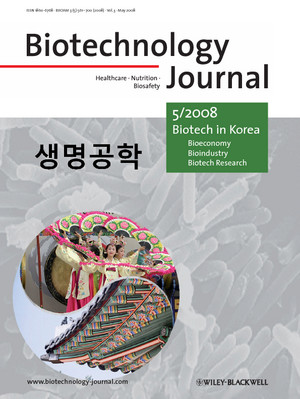 International Science Journal Spotlights Korean Biotechnology
Biotechnology Journal published by German-based Wiley-VCH, one of the world"s major scientific and technical publishers, devoted its entire special edition for May to biotechnology in Korea.
The monthly journal"s special issue was planned by KAIST Professor Sang-Yup Lee of the Chemical and Biomolecular Engineering Department who is one of the journal"s two editors-in-chief.
The special issue outlines the current status and future prospect of biotechnology in Korea, and presents five review papers and eight original papers by leading Korean biotech researchers to showcase recent developments in Korean biotechnology. Among these papers, a review by Dr. Byung-Hwan Hyeon and his colleagues describes in detail the Korean biotechnology strategies represented by "Bio-Vision 2016," and another by Dr. Ji-Hyun Kim and his collaborators presents recent progress in microbial genome projects in Korea.
In the editorial of the journal, Prof. Lee said, "Heavy industry and IT industry have been the two drivers of Korean economic growth. Korea is now considering biotechnology as its next generation growth engine."
Underscoring the growing importance of fusion research, he mentioned that integration of biotechnology with information technology and nanotechnology is advancing rapidly in Korea. Another special edition of Biotechnology Journal focusing on these exciting biotech developments in Korea is planned for the future.
2008.05.20 View 16457
International Science Journal Spotlights Korean Biotechnology
Biotechnology Journal published by German-based Wiley-VCH, one of the world"s major scientific and technical publishers, devoted its entire special edition for May to biotechnology in Korea.
The monthly journal"s special issue was planned by KAIST Professor Sang-Yup Lee of the Chemical and Biomolecular Engineering Department who is one of the journal"s two editors-in-chief.
The special issue outlines the current status and future prospect of biotechnology in Korea, and presents five review papers and eight original papers by leading Korean biotech researchers to showcase recent developments in Korean biotechnology. Among these papers, a review by Dr. Byung-Hwan Hyeon and his colleagues describes in detail the Korean biotechnology strategies represented by "Bio-Vision 2016," and another by Dr. Ji-Hyun Kim and his collaborators presents recent progress in microbial genome projects in Korea.
In the editorial of the journal, Prof. Lee said, "Heavy industry and IT industry have been the two drivers of Korean economic growth. Korea is now considering biotechnology as its next generation growth engine."
Underscoring the growing importance of fusion research, he mentioned that integration of biotechnology with information technology and nanotechnology is advancing rapidly in Korea. Another special edition of Biotechnology Journal focusing on these exciting biotech developments in Korea is planned for the future.
2008.05.20 View 16457 -
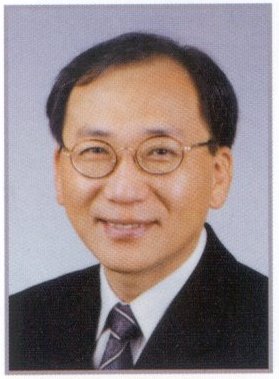 World Micromachine Summit to Open in Daejeon
The 2008 World Micromachine Summit will be held at Hotel Riviera in Daejeon for a four-day run from April 30, drawing worldwide industrial and academic leaders in the micro-nano-technology (MNT).
Organizers say that 76 delegates and 56 observers from 19 countries and regions will take part in this year"s Micromachine Summit. Prof. Cho Young-ho of the Department of Bio & Brain Engineering of KAIST will play host to the annual event.
Participants will discuss the progress of micro-nano-technology in each country and region development of national policies in this area. The Summit was first organized in 1995 by the Micromachine Center of Japan with representatives from 10 countries participating. They were Australia, Canada, Germany, Italy, Japan, the Netherlands, Switzerland, the United Kingdom, and the United States.
Korea was first invited to the conference in 1999. Since then, Korea has played an active role in promoting technological exchanges among nations and has conducted presentations and discussions on major technological breakthroughs.
During the four-day run, each delegation will outline their country"s policies and strategies and present local features on focused areas including this year"s main theme, "Micromachine towards Technology Convergence Era."
The gathering will offer a valuable opportunity for the participants to exchange and collect information on the current state of the MNT, as well as providing a forum for worldwide networking of leaders in the area.
2008.04.29 View 15382
World Micromachine Summit to Open in Daejeon
The 2008 World Micromachine Summit will be held at Hotel Riviera in Daejeon for a four-day run from April 30, drawing worldwide industrial and academic leaders in the micro-nano-technology (MNT).
Organizers say that 76 delegates and 56 observers from 19 countries and regions will take part in this year"s Micromachine Summit. Prof. Cho Young-ho of the Department of Bio & Brain Engineering of KAIST will play host to the annual event.
Participants will discuss the progress of micro-nano-technology in each country and region development of national policies in this area. The Summit was first organized in 1995 by the Micromachine Center of Japan with representatives from 10 countries participating. They were Australia, Canada, Germany, Italy, Japan, the Netherlands, Switzerland, the United Kingdom, and the United States.
Korea was first invited to the conference in 1999. Since then, Korea has played an active role in promoting technological exchanges among nations and has conducted presentations and discussions on major technological breakthroughs.
During the four-day run, each delegation will outline their country"s policies and strategies and present local features on focused areas including this year"s main theme, "Micromachine towards Technology Convergence Era."
The gathering will offer a valuable opportunity for the participants to exchange and collect information on the current state of the MNT, as well as providing a forum for worldwide networking of leaders in the area.
2008.04.29 View 15382 -
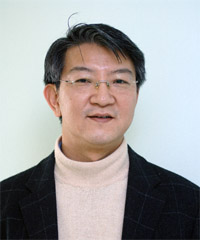 Prof. Sang-Yup Lee Co-Editor-in-Chief of Biotechnology Journal
Prof. Sang-Yup Lee of KAIST"s Department of Chemical and Biomolecular Engineering has been appointed as co-editor-in-chief of Biotechnology Journal published by Wiley-VCH, a German-based leading technical publisher, university authorities said Tuesday, April 15.
Launched in January 2006, Biotechnology Journal has covered biological process, brain ailments, biological medicine, protein design and other applied bio-sciences.
Starting in May, Lee will be responsible for setting and overseeing editorial direction of the journal along with Prof. Alois Jungbauer of Austria.
Professor Lee has been gaining recognition in and outside the country for his research on metabolic engineering. In 2002, he was chosen as one of Asia"s next generation leaders by the World Economic Forum. In 2007, Lee was elected a fellow of the American Association for the Advancement of Science, the world"s largest general scientific society. He is also serving as an editorial member of more than ten international journals including Biotechnology & Bioengineering.
Awards and honors include the First Young Scientist"s Award from the President of Korea, the Scientist of the Month Award from the Korean Ministry of Science and Technology, the Best Patent Award from Korean Intellectual Property Office, the Citation Classic Award from ISI, USA, and the First Elmer Gaden Award (1999 Best Paper Award) from Biotechnology and Bioengineering (John Wiley & Sons, USA) at the ACS National meeting.
2008.04.16 View 15642
Prof. Sang-Yup Lee Co-Editor-in-Chief of Biotechnology Journal
Prof. Sang-Yup Lee of KAIST"s Department of Chemical and Biomolecular Engineering has been appointed as co-editor-in-chief of Biotechnology Journal published by Wiley-VCH, a German-based leading technical publisher, university authorities said Tuesday, April 15.
Launched in January 2006, Biotechnology Journal has covered biological process, brain ailments, biological medicine, protein design and other applied bio-sciences.
Starting in May, Lee will be responsible for setting and overseeing editorial direction of the journal along with Prof. Alois Jungbauer of Austria.
Professor Lee has been gaining recognition in and outside the country for his research on metabolic engineering. In 2002, he was chosen as one of Asia"s next generation leaders by the World Economic Forum. In 2007, Lee was elected a fellow of the American Association for the Advancement of Science, the world"s largest general scientific society. He is also serving as an editorial member of more than ten international journals including Biotechnology & Bioengineering.
Awards and honors include the First Young Scientist"s Award from the President of Korea, the Scientist of the Month Award from the Korean Ministry of Science and Technology, the Best Patent Award from Korean Intellectual Property Office, the Citation Classic Award from ISI, USA, and the First Elmer Gaden Award (1999 Best Paper Award) from Biotechnology and Bioengineering (John Wiley & Sons, USA) at the ACS National meeting.
2008.04.16 View 15642 -
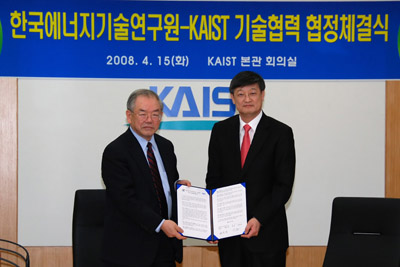 KAIST Inks Agreement with KERI for EEWS Technological Cooperation
KAIST concluded an agreement with the Korea Institute of Energy Research for technological cooperation in the research on the four global issues of energy, environment, water and sustainability (EEWS) on Tuesday (April 15).
The agreement was signed by KAIST President Nam-Pyo Suh and Moon-Hee Han, director of the Korea Institute of Energy Research at the KAIST.
The agreement calls for building a cooperative network for exchanges of personnel and information, and joint use of research facilities and equipment between the two institutions. Under the agreement, KAIST and KIER will also jointly conduct scientific researches.
When it comes to personnel exchange, KAIST will appoint researchers of KIER as adjunct professors of KAIST, while KIER will appoint KAIST professors as its adjunct researchers. Undergraduate students of KAIST will be given an opportunity to join government-commissioned projects and participate in an internship program of the institute.
2008.04.16 View 18859
KAIST Inks Agreement with KERI for EEWS Technological Cooperation
KAIST concluded an agreement with the Korea Institute of Energy Research for technological cooperation in the research on the four global issues of energy, environment, water and sustainability (EEWS) on Tuesday (April 15).
The agreement was signed by KAIST President Nam-Pyo Suh and Moon-Hee Han, director of the Korea Institute of Energy Research at the KAIST.
The agreement calls for building a cooperative network for exchanges of personnel and information, and joint use of research facilities and equipment between the two institutions. Under the agreement, KAIST and KIER will also jointly conduct scientific researches.
When it comes to personnel exchange, KAIST will appoint researchers of KIER as adjunct professors of KAIST, while KIER will appoint KAIST professors as its adjunct researchers. Undergraduate students of KAIST will be given an opportunity to join government-commissioned projects and participate in an internship program of the institute.
2008.04.16 View 18859 -
 KAIST Receiving Applications for Intelligent SoC Robot War
KAIST is receiving applications to participate in the 2008 Intelligent SoC Robot War through the annual contest"s homepage at www.socrobotwar.org. Application deadline is May 1.
The annual contest features battles between mechanical robots utilizing System on Chip (SoC) technology. The annual robot competition, which began in 2002, is scheduled for Oct. 15-19 this year at the Indian Hall of Convention & Exhibition Center (COEX) in southern Seoul.
The Intelligent SoC Robot War Contest has two sections, Tank Robot and Taekwon Robot. In the Tank Robot contest, robots in the form of tanks engage in duels with laser beams through visual recognition, wireless communication, and audio recognition. On the other hand, the Taekwon Robot contest is a hand-to-hand fight. The robots had to be capable of defending, recognizing the opponent, and attacking without external control.
Any team consisting of more than two people and under six undergraduate or graduate students are eligible to take part in the competition.
Prior to the contest, preliminary assessments and the final selection will be made between July and September.
2008.04.14 View 15572
KAIST Receiving Applications for Intelligent SoC Robot War
KAIST is receiving applications to participate in the 2008 Intelligent SoC Robot War through the annual contest"s homepage at www.socrobotwar.org. Application deadline is May 1.
The annual contest features battles between mechanical robots utilizing System on Chip (SoC) technology. The annual robot competition, which began in 2002, is scheduled for Oct. 15-19 this year at the Indian Hall of Convention & Exhibition Center (COEX) in southern Seoul.
The Intelligent SoC Robot War Contest has two sections, Tank Robot and Taekwon Robot. In the Tank Robot contest, robots in the form of tanks engage in duels with laser beams through visual recognition, wireless communication, and audio recognition. On the other hand, the Taekwon Robot contest is a hand-to-hand fight. The robots had to be capable of defending, recognizing the opponent, and attacking without external control.
Any team consisting of more than two people and under six undergraduate or graduate students are eligible to take part in the competition.
Prior to the contest, preliminary assessments and the final selection will be made between July and September.
2008.04.14 View 15572 -
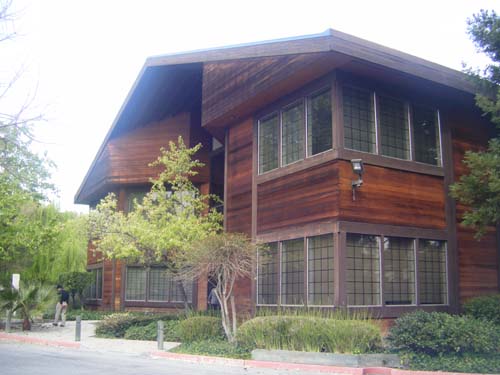 KAIST to Open Liaison Office in Silicon Valley
KAIST will open a liaison office in Silicon Valley, California, within the first half of this year to serve as a beachhead of its operations in the United States, university authorities announced Monday.
The opening of "KAIST America" office will be financially supported by the Silicon Valley-based Ambex Venture Group. The liaison office will be located at the first floor of the AmBex building in Sunnyvale.
The liaison office will be responsible for overseeing joint research between KAIST and the U.S. National Aeronautics and Space Administration (NASA) and KAIST"s other cooperative projects in research and development with enterprises and universities in Silicon Valley. It will also be engaged in forming a network among KAIST alumni members in the United States, raising funds within the U.S. and managing the money. The office will arrange KAIST students" internship in the companies in Silicon Valley.
"KAIST America is part of the globalization strategies that KAIST has pursued consistently. It is aimed at helping set up venture firms based on the technologies that KAIST has developed so far and generating funds needed for further development of the university," said Sun-Heung Jang, KAIST vice president.
AmBex, a venture capital company that invests in information technology, health science and financial service firms, was founded by Jong-Moon Lee, a member of Presidents" Advisory Council at KAIST. The AmBex building is situated near Stanford University, University of California in Berkeley, Google and Yahoo.
KAIST President Nam Pyo Suh will invite Stanford and UC Berkeley professors, executives of Silicon Valley enterprises and KAIST alumni in the area to the opening ceremony of the liaison office to be held some time in the first half of this year.
2008.03.25 View 14784
KAIST to Open Liaison Office in Silicon Valley
KAIST will open a liaison office in Silicon Valley, California, within the first half of this year to serve as a beachhead of its operations in the United States, university authorities announced Monday.
The opening of "KAIST America" office will be financially supported by the Silicon Valley-based Ambex Venture Group. The liaison office will be located at the first floor of the AmBex building in Sunnyvale.
The liaison office will be responsible for overseeing joint research between KAIST and the U.S. National Aeronautics and Space Administration (NASA) and KAIST"s other cooperative projects in research and development with enterprises and universities in Silicon Valley. It will also be engaged in forming a network among KAIST alumni members in the United States, raising funds within the U.S. and managing the money. The office will arrange KAIST students" internship in the companies in Silicon Valley.
"KAIST America is part of the globalization strategies that KAIST has pursued consistently. It is aimed at helping set up venture firms based on the technologies that KAIST has developed so far and generating funds needed for further development of the university," said Sun-Heung Jang, KAIST vice president.
AmBex, a venture capital company that invests in information technology, health science and financial service firms, was founded by Jong-Moon Lee, a member of Presidents" Advisory Council at KAIST. The AmBex building is situated near Stanford University, University of California in Berkeley, Google and Yahoo.
KAIST President Nam Pyo Suh will invite Stanford and UC Berkeley professors, executives of Silicon Valley enterprises and KAIST alumni in the area to the opening ceremony of the liaison office to be held some time in the first half of this year.
2008.03.25 View 14784 -
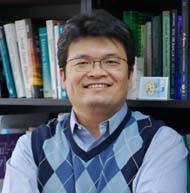 Prof. Kim Receives Lee Osheroff Prize
Professor Eun-Seong Kim of the Department of Physics has been selected as the winner of the Lee Osheroff Richardson Prize for 2008.
The award was established in honor of the 1996 Nobel Prize laureates in Physics David Lee, Douglas Osheroff, and Robert Richardson for their discovery in superfluidity in helium-3. The annual prize sponsored by Oxford Instruments NanoScience is awarded to a young scientist who has made a notable achievement in the field of low temperatures and high magnetic fields.
Kim was chosen as the winner of this prestigious award for his contributions to the understanding of solid helium. Through research, Professor Kim found superfluid-like behavior in solid helium and with this discovery it is shown that all three states of matter can exhibit superfluid behavior.
The Lee Osheroff Richardson Prize recipient is selected by the North American Prize Committee which is composed of prominent figures in the low temperature and high magnetic fields including Professor Bruce Gaulin of McMaster University, who chairs the Prize Committee. The award ceremony was held on March 11 in New Orleans.
2008.03.18 View 15527
Prof. Kim Receives Lee Osheroff Prize
Professor Eun-Seong Kim of the Department of Physics has been selected as the winner of the Lee Osheroff Richardson Prize for 2008.
The award was established in honor of the 1996 Nobel Prize laureates in Physics David Lee, Douglas Osheroff, and Robert Richardson for their discovery in superfluidity in helium-3. The annual prize sponsored by Oxford Instruments NanoScience is awarded to a young scientist who has made a notable achievement in the field of low temperatures and high magnetic fields.
Kim was chosen as the winner of this prestigious award for his contributions to the understanding of solid helium. Through research, Professor Kim found superfluid-like behavior in solid helium and with this discovery it is shown that all three states of matter can exhibit superfluid behavior.
The Lee Osheroff Richardson Prize recipient is selected by the North American Prize Committee which is composed of prominent figures in the low temperature and high magnetic fields including Professor Bruce Gaulin of McMaster University, who chairs the Prize Committee. The award ceremony was held on March 11 in New Orleans.
2008.03.18 View 15527 -
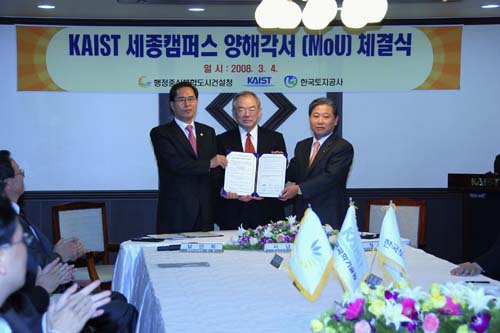 KAIST to Build Branch Campus in New Administrative City
KAIST signed a memorandum of understanding (MOU) with the Multifunctional Administrative City Construction Agency and the Korea Land Corporation on March 4 to build a branch campus in the city now under construction to house many government organizations to be relocated from Seoul.
The MOU calls for building a well-facilitated KAIST campus on 310,000 square meters of land within the planned city, about 30 kilometers west of Daejeon. The multifunctional city, named Sejong City, is scheduled to be dedicated in 2014.
The MAC now being built in the Yongi-Gongju area of South Chungcheong Province is geographically in the center of South Korea, and many governmental agencies and major public organizations will move in from 2015.
The KAIST campus is envisioned to be home to a newly established College of Strategy and Policy, a Strategy and Policy Research Center, and an Innovative Technology Research Center. The College of Medical Science currently based in the Daejeon campus will be relocated to the campus. With a research-oriented hospital and a medical engineering research center, KAIST hopes to become a leading institution in disease treatment and medical engineering technologies.
The new campus is also expected to house new KAIST colleges now in the planning stage which will offer interdisciplinary courses such as the College of IT and Contents and the College of Life Sciences. KAIST also seeks to resolve housing shortage problems by building an in-campus village designed to provide international living environment for professors and students on the planned campus
2008.03.18 View 16918
KAIST to Build Branch Campus in New Administrative City
KAIST signed a memorandum of understanding (MOU) with the Multifunctional Administrative City Construction Agency and the Korea Land Corporation on March 4 to build a branch campus in the city now under construction to house many government organizations to be relocated from Seoul.
The MOU calls for building a well-facilitated KAIST campus on 310,000 square meters of land within the planned city, about 30 kilometers west of Daejeon. The multifunctional city, named Sejong City, is scheduled to be dedicated in 2014.
The MAC now being built in the Yongi-Gongju area of South Chungcheong Province is geographically in the center of South Korea, and many governmental agencies and major public organizations will move in from 2015.
The KAIST campus is envisioned to be home to a newly established College of Strategy and Policy, a Strategy and Policy Research Center, and an Innovative Technology Research Center. The College of Medical Science currently based in the Daejeon campus will be relocated to the campus. With a research-oriented hospital and a medical engineering research center, KAIST hopes to become a leading institution in disease treatment and medical engineering technologies.
The new campus is also expected to house new KAIST colleges now in the planning stage which will offer interdisciplinary courses such as the College of IT and Contents and the College of Life Sciences. KAIST also seeks to resolve housing shortage problems by building an in-campus village designed to provide international living environment for professors and students on the planned campus
2008.03.18 View 16918 -
 KAIST, K-Water Sign MOU for Cooperation in EEWS
KAIST has signed a memorandum of understanding with the Korea Water Resources Corporation (K-Water), a state-invested organization responsible for the development and management of inland water resources, for cooperation in the research on the four global issues of energy, environment, water and sustainability (EEWS).
The MOU was signed by KAIST President Suh Nam-Pyo and K-Water President Kwak Kyul-ho on Feb. 22 at the KAIST.
KAIST and K-Water agreed to establish a cooperative network for exchanges of personnel and research resources for advanced R&D on EEWS. The agreement has been reached on the common belief that EEWS is the most imminent problem facing the humanity in the 21st century.
Under the MOU, KAIST and K-Water will work together to build a EEWS global network; to develop policies and conduct researches to strengthen the competitiveness of Korea"s water industry; and to train and exchange research manpower of the two institutions. The agreement also calls for sharing technological information, exchanging research results and publications; and jointly hosting symposiums and workshops.
2008.03.09 View 16994
KAIST, K-Water Sign MOU for Cooperation in EEWS
KAIST has signed a memorandum of understanding with the Korea Water Resources Corporation (K-Water), a state-invested organization responsible for the development and management of inland water resources, for cooperation in the research on the four global issues of energy, environment, water and sustainability (EEWS).
The MOU was signed by KAIST President Suh Nam-Pyo and K-Water President Kwak Kyul-ho on Feb. 22 at the KAIST.
KAIST and K-Water agreed to establish a cooperative network for exchanges of personnel and research resources for advanced R&D on EEWS. The agreement has been reached on the common belief that EEWS is the most imminent problem facing the humanity in the 21st century.
Under the MOU, KAIST and K-Water will work together to build a EEWS global network; to develop policies and conduct researches to strengthen the competitiveness of Korea"s water industry; and to train and exchange research manpower of the two institutions. The agreement also calls for sharing technological information, exchanging research results and publications; and jointly hosting symposiums and workshops.
2008.03.09 View 16994 -
 2008 Commencement Ceremony Held
The 2008 KAIST Commencement Ceremony was held on Feb. 29 at the KAIST Amphitheater in the presence of KAIST President Nam Pyo Suh, U.S. Ambassador to Korea Alexander Vershbow, alumni representatives and parents.
Other dignitaries on hand included National Assemblymen Sang-Kee Suh, Chang-Sun Hong and Sang-Min Lee; and Daejoen City Major Sung-Hyo Park.
President Suh and Vice President Soon-Heung Chang presented degrees to each of the 1,321 graduates (200 doctors, 725 masters and 396 bachelors) instead of just to representatives. Since its inception in 1971, KAIST has produced 7,067 Ph.D. graduates, 18,636 master"s degree holders and 8,998 bachelor"s degree holders. This year, 40 percent of the Ph.D. graduates, 79, were in their twenties upon graduation.
President Suh called on the graduates to return the favor they received from society by making their share of contributions to humanity. "You were chosen to be students of this unique university because the Korean people -- not only KAIST professors and staff, but also ordinary taxpayers -- believe that outstanding young people like you can change the world in which we live for the better. Now it is time for you to pay back their support," he said.
Notable graduates of this year include So-Yeon Yi, 29, the first Korean female astronaut candidate, who earned her doctorate degree in bio and brain engineering. She was granted a special award in recognition of her role in advancing space science in Korea but she could not attend the graduation ceremony due to her training schedule in Russia which will continue until April.
Eun-Gyu Oh, 26, was the youngest doctorate recipient in the ceremony and Won Hye-jeong, 21, recorded the top undergraduate GPA with a score of 4.20 over 4.3. Civil and environmental engineering major Seung-Hee Park, 28, published a total of eight papers in major international journals while attending KAIST and two more papers are currently under review.
So-Yeon Yi said: ``I frequently stayed up all night to research and write the paper. It was tough experience for me. Thanks to ceaseless support from professors and colleagues, however, I was able to complete the task,"" she said. ``I have done my best in studying, exercising and so on. I"m sure that my active, participatory attitude brought about this honorable moment.""
She is now training at Gagarin Cosmonaut Training Center near Moscow as a replacement astronaut in case Koh San, 31, who is to be the first Korean astronaut, is unable to go into orbit.
Koh and Yi were selected from more than 36,000 applicants last year. Koh was finally picked as the primary candidate last September. The two are serving as space ambassadors appointed by the Ministry of Science & Technology.
2008.03.09 View 17437
2008 Commencement Ceremony Held
The 2008 KAIST Commencement Ceremony was held on Feb. 29 at the KAIST Amphitheater in the presence of KAIST President Nam Pyo Suh, U.S. Ambassador to Korea Alexander Vershbow, alumni representatives and parents.
Other dignitaries on hand included National Assemblymen Sang-Kee Suh, Chang-Sun Hong and Sang-Min Lee; and Daejoen City Major Sung-Hyo Park.
President Suh and Vice President Soon-Heung Chang presented degrees to each of the 1,321 graduates (200 doctors, 725 masters and 396 bachelors) instead of just to representatives. Since its inception in 1971, KAIST has produced 7,067 Ph.D. graduates, 18,636 master"s degree holders and 8,998 bachelor"s degree holders. This year, 40 percent of the Ph.D. graduates, 79, were in their twenties upon graduation.
President Suh called on the graduates to return the favor they received from society by making their share of contributions to humanity. "You were chosen to be students of this unique university because the Korean people -- not only KAIST professors and staff, but also ordinary taxpayers -- believe that outstanding young people like you can change the world in which we live for the better. Now it is time for you to pay back their support," he said.
Notable graduates of this year include So-Yeon Yi, 29, the first Korean female astronaut candidate, who earned her doctorate degree in bio and brain engineering. She was granted a special award in recognition of her role in advancing space science in Korea but she could not attend the graduation ceremony due to her training schedule in Russia which will continue until April.
Eun-Gyu Oh, 26, was the youngest doctorate recipient in the ceremony and Won Hye-jeong, 21, recorded the top undergraduate GPA with a score of 4.20 over 4.3. Civil and environmental engineering major Seung-Hee Park, 28, published a total of eight papers in major international journals while attending KAIST and two more papers are currently under review.
So-Yeon Yi said: ``I frequently stayed up all night to research and write the paper. It was tough experience for me. Thanks to ceaseless support from professors and colleagues, however, I was able to complete the task,"" she said. ``I have done my best in studying, exercising and so on. I"m sure that my active, participatory attitude brought about this honorable moment.""
She is now training at Gagarin Cosmonaut Training Center near Moscow as a replacement astronaut in case Koh San, 31, who is to be the first Korean astronaut, is unable to go into orbit.
Koh and Yi were selected from more than 36,000 applicants last year. Koh was finally picked as the primary candidate last September. The two are serving as space ambassadors appointed by the Ministry of Science & Technology.
2008.03.09 View 17437 -
 Women Leaders Awarded Honorary Degrees
Korea"s two women leaders, Park Geun-hye, former President of the Grand National Party, and Lee Gil-ya, chairperson of the Gachon Gil Foundation, a major medical services organization, were awarded honorary doctorate degrees by KAIST, Korea"s state-run science and technology research university, on Feb. 29.
It is the first time in the school"s 37-year history that women have been awarded honorary doctorate degrees. Park and Lee were conferred with the honor during the university"s 2008 graduation ceremony in recognition of their achievements in social services.
KAIST President Suh Nam-pyo said that the university decided to confer honorary doctorate degrees to Park and Lee, who both have educational backgrounds in the fields of engineering and science, in order to present role models to female students in science and engineering who still make up a relatively small percentage of the total enrollment at KAIST and throughout Korean universities.
"Our graduates and future students will strive to make meaningful contributions to the nation and the world, just as the two women leaders have done so well, for so many years," said Suh in his commencement address.
Female students constitute 23 percent of the total enrollment of 7,800, including graduate and doctorate students.
The honorary doctorate citation said Park Geun-hye, a graduate of the Department of Electronic Engineering, Sogang University in Seoul, has exerted strenuous efforts for the advancement of science and technology education and women"s social role. Among other things, Park called for the launching of a "second-stage science and technology revolution" during her 2007 presidential campaign. She declared science and technology as "the most crucial area of national development and survival" and instituted seven-point strategies to innovate the nation"s science and technology. Those strategies are specifically aimed at increasing investment in science and technology, fostering a world-class science and technology university and creating science-friendly curriculum at schools.
Lee Gil-ya, a widely-revered medical doctor, has demonstrated outstanding leadership in education, culture, journalism and business management, according to her citation. Throughout her brilliant professional career, she has vigorously pursued her lifelong goal of philanthropy, social service and patriotism. In particular, her dedication to nurturing young talents is widely recognized in Korea.
2008.03.05 View 15454
Women Leaders Awarded Honorary Degrees
Korea"s two women leaders, Park Geun-hye, former President of the Grand National Party, and Lee Gil-ya, chairperson of the Gachon Gil Foundation, a major medical services organization, were awarded honorary doctorate degrees by KAIST, Korea"s state-run science and technology research university, on Feb. 29.
It is the first time in the school"s 37-year history that women have been awarded honorary doctorate degrees. Park and Lee were conferred with the honor during the university"s 2008 graduation ceremony in recognition of their achievements in social services.
KAIST President Suh Nam-pyo said that the university decided to confer honorary doctorate degrees to Park and Lee, who both have educational backgrounds in the fields of engineering and science, in order to present role models to female students in science and engineering who still make up a relatively small percentage of the total enrollment at KAIST and throughout Korean universities.
"Our graduates and future students will strive to make meaningful contributions to the nation and the world, just as the two women leaders have done so well, for so many years," said Suh in his commencement address.
Female students constitute 23 percent of the total enrollment of 7,800, including graduate and doctorate students.
The honorary doctorate citation said Park Geun-hye, a graduate of the Department of Electronic Engineering, Sogang University in Seoul, has exerted strenuous efforts for the advancement of science and technology education and women"s social role. Among other things, Park called for the launching of a "second-stage science and technology revolution" during her 2007 presidential campaign. She declared science and technology as "the most crucial area of national development and survival" and instituted seven-point strategies to innovate the nation"s science and technology. Those strategies are specifically aimed at increasing investment in science and technology, fostering a world-class science and technology university and creating science-friendly curriculum at schools.
Lee Gil-ya, a widely-revered medical doctor, has demonstrated outstanding leadership in education, culture, journalism and business management, according to her citation. Throughout her brilliant professional career, she has vigorously pursued her lifelong goal of philanthropy, social service and patriotism. In particular, her dedication to nurturing young talents is widely recognized in Korea.
2008.03.05 View 15454